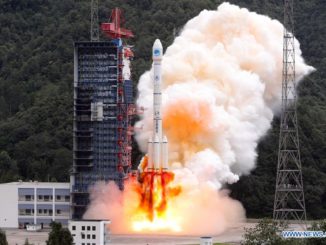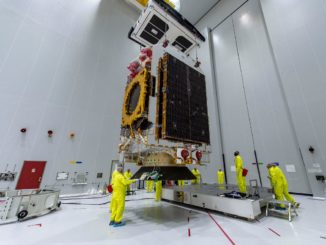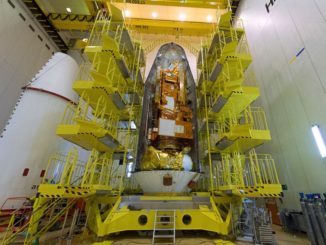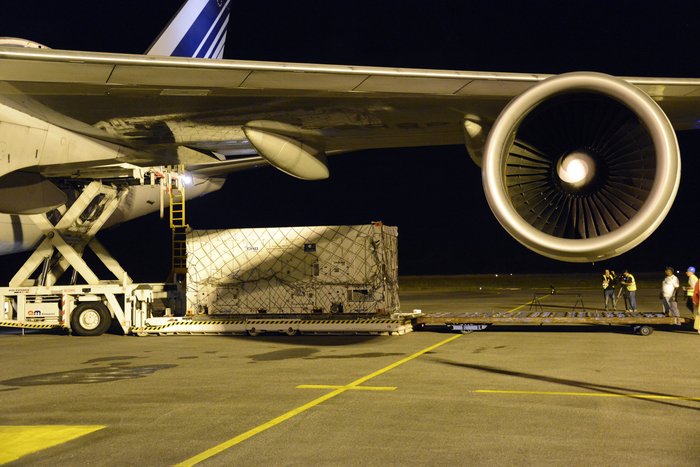
Two Galileo navigation satellites arrived at the Guiana Space Center in South America on Thursday after a trans-Atlantic flight from Paris, as European officials plan the resumption of Galileo launches after a rocket mishap deposited two spacecraft in the wrong orbit last year.
Launch of the next two Galileo satellites is scheduled for March 26. If the spacecraft target Plane B of the European navigation constellation — as currently planned — launch time is set for 2150:20 GMT (5:50 p.m. EDT; 6:50 p.m. local time).
When fully deployed, the Galileo system will include 30 satellites scattered in three orbital planes around Earth. The $7.2 billion program is a civilian-run counterpart to the U.S. Air Force’s Global Positioning System.
The satellites arrived aboard an Air France Boeing 747 cargo plane Thursday. After off-loading at the Cayenne airport, the spacecraft and their climate-controlled containers were trucked to Kourou and placed in a clean room at the Guiana Space Center.
Over the next few weeks, technicians will fuel the spacecraft with maneuvering propellant, complete final testing, attach them to a custom-made dispenser and join the Galileo satellites with the Soyuz rocket’s Fregat upper stage.
After the satellites are enclosed inside the Soyuz rocket’s 4.1-meter (13.5-foot) diameter fairing, workers will transfer the upper composite to the Soyuz launch pad on the northwest side of the European-run space center to join the three-stage booster a few days before liftoff.
Built by OHB of Bremen, Germany, the spacecraft delivered to French Guiana on Thursday will be the seventh and eighth Galileo satellites to launch since Europe began filling the constellation with validation test platforms in 2011.
The last launch of Galileo satellites was a failure, dropping off the spacecraft in an off-target orbit and leading European officials to forego a chance to launch two more spacecraft before the end of 2014.
Investigators discovered hydrazine fuel feeding two maneuvering thrusters on the Fregat upper stage froze in flight, preventing the engine from pointing in the right direction for a rocket burn designed to put the Galileo satellites into a circular orbit 23,500 kilometers (14,600 miles) above Earth.
With the rocket pointing in the wrong direction, the Fregat engine firing propelled the Galileo satellites into an orbit with a perigee, or low point, below the targeted altitude and an apogee, or high point, above it.
Engineers blamed the mishap on a hydrazine fuel line that was routed next to a line carrying super-cold helium pressurant. Their proximity caused the hydrazine fuel line to freeze.
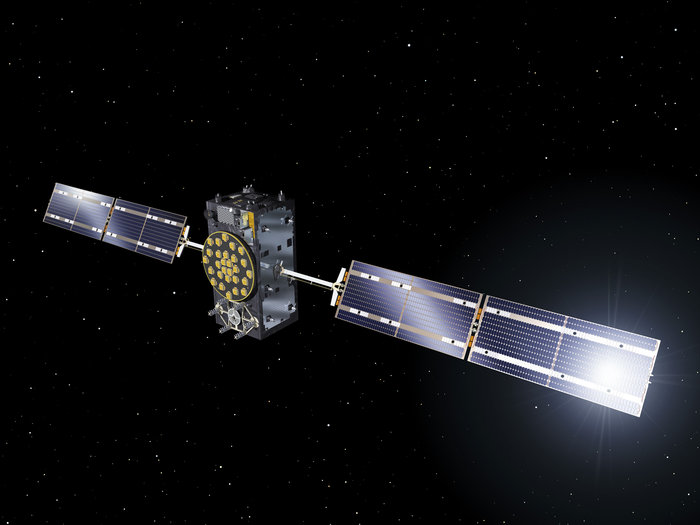
The December Soyuz launch slot at the Guiana Space Center instead went to O3b Networks, which put four of its broadband communications satellites on the flight. The Soyuz rocket and Fregat upper stage successfully put the O3b spacecraft in the right orbit.
The European Commission, which manages the Galileo navigation program, announced Jan. 28 it would launch up to six Galileo satellites on three Soyuz rocket missions in 2015, beginning in late March.
Officials had the option of launching the next batch of Galileo satellites on an Ariane 5 rocket, which can haul up to four of the spacecraft in a single flight. But Arianespace, which operates the Ariane 5 and Soyuz rockets in French Guiana, said it had openings for launches sooner on the Soyuz manifest.
The March 26 liftoff will be the 11th flight of a Soyuz rocket from French Guiana since the venerable Russian launcher began operating from the jungle spaceport in 2011. All three Soyuz launches planned from French Guiana this year will carry Galileo satellites.
The European Space Agency, which acts as a technical and contracting agent for the Galileo program, says ground controllers have repositioned one of the two satellites launched into the wrong orbit in August into a more circular path around Earth, allowing engineers to start testing of its navigation payload.
The orbit is still elliptical and does not match the circular orbit planned for the rest of the Galileo navigation satellites, but officials say the altitude adjustments after the August launch keep the spacecraft out of hazardous radiation belts and should allow the platform to be used with the rest of the Galileo fleet.
Similar maneuvers are planned for the second satellite launched in August.
Follow Stephen Clark on Twitter: @StephenClark1.

